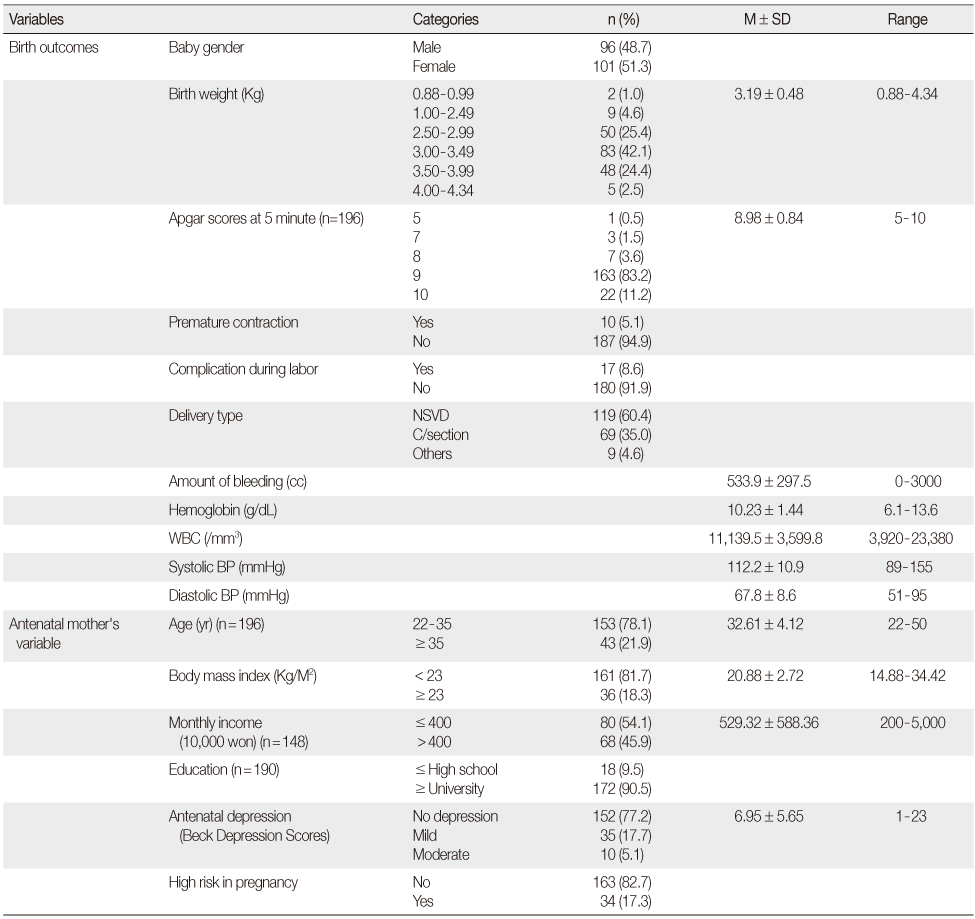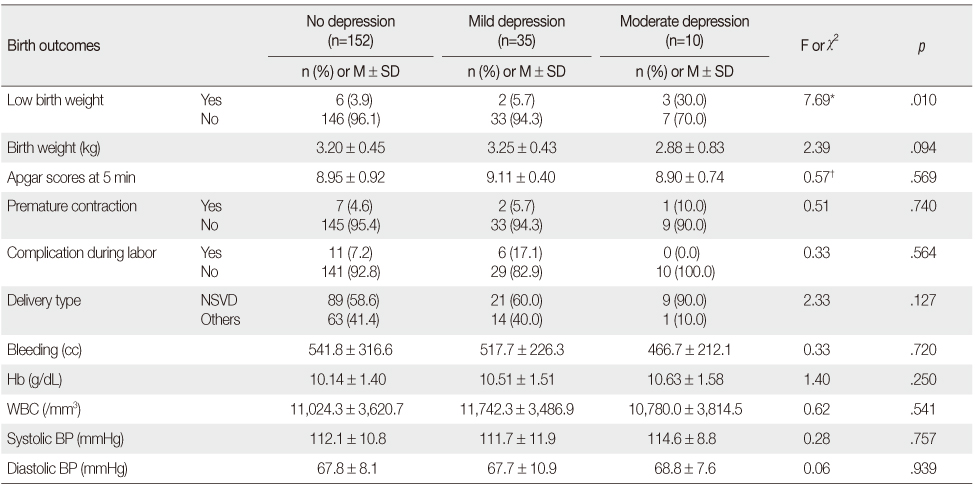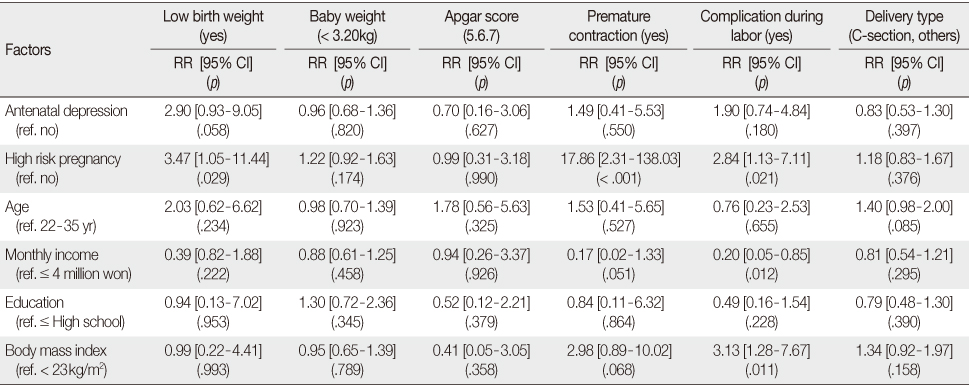Articles
- Page Path
- HOME > J Korean Acad Nurs > Volume 42(4); 2012 > Article
-
Original Article
- Effects of Antenatal Depression and Antenatal Characteristics of Pregnant Women on Birth Outcomes: A Prospective Cohort Study
- Hae Won Kim, Yeon Yi Jung
-
Journal of Korean Academy of Nursing 2012;42(4):477-485.
DOI: https://doi.org/10.4040/jkan.2012.42.4.477
Published online: August 31, 2012
1Department of Nursing, College of Medicine, Kwandong University, Gangreung, Korea.
2Clinical Quality Improvement Team, Samsung Medical Center, Seoul, Korea.
- Address reprint requests to: Jung, Yeon Yi. Department of Quality Assurance Samsung Medical Center, 50 Irwon-dong, Ganmam-gu, Seoul 135-710, Korea. Tel: +82-2-3410-3055, Fax: +82-2-3410-2850, yoenyi.jung@samsung.com
© 2012 Korean Society of Nursing Science
Abstract
-
Purpose
- This study was done to evaluate the effects of antenatal depression on birth outcomes.
-
Methods
- The participants were 255 pregnant women who were followed in a prospective study. Of these, 197 cases were examined included birth weight, Apgar scores at 5 minute, premature contraction, complication of labor, delivery types and laboratory data. Descriptive statistics, ANOVA, Chi square test of linear by linear association, Kruskal Wallis test, Relative Risk, univariate and adjusted multiple logistic regression were used for data analysis with SPSS/Win.
-
Results
- Level of antenatal depression was associated with low birth weight (χ2=7.69, p=.010). High risk pregnancy was a predictor of low birth weight (OR=6.98 [1.21-40.30]) and baby's weight (OR=2.12, [1.05-4.28]). Prepregnancy body mass index (BMI) was a predictor of complications in labor (OR=3.59, [1.03-12.48]). But there were no significant effects of antenatal depression on other birth outcomes.
-
Conclusion
- The results of this study indicate that women with antenatal depression, high risk pregnancy, prepregnancy BMI≥23 kg/M2 should be monitored and managed to ensure favorable birth outcomes.
- 1. Andersson L, Sundstrom-Poromaa I, Wulff M, Astrom M, Bixo M. Neonatal outcome following maternal antenatal depression and anxiety: A population based study. American Journal of Epidemiology. 2004a;159:872–881. http://dx.doi.org/10.1093/aje/kwh122.ArticlePubMed
- 2. Andersson L, Sundstrom-Poromaa I, Wulff M, Astrom M, Bixo M. Implications of antenatal depression and anxiety for obstetric outcomes. Obstetrics and Gynecology. 2004b;104:467–476. http://dx.doi.org/10.1097/01.AOG.0000135277.04565.e9.PubMed
- 3. Aum JA, Jung HJ, Huh JW, Hong SY. Factors influencing birth weight premature infants. Korean Journal of Pediatrics. 2007;50:954–958. http://dx.doi.org/10.3345/kjp.2007.50.10.954.Article
- 4. Brandon AR, Trivedi MH, Hynan LS, Miltenberger PD, Labat DB, Rifkin JB, et al. Prenatal depression in women hospitalized for obstetric risk. Journal of Clinical Psychiatry. 2008;69:635–643.ArticlePubMed
- 5. Brooten D, Youngblut JM, Brown L, Finkler SA, Neff DF, Madigan E. A randomized trial of nurse specialist home care for women with high risk pregnancies: Outcomes and costs. The American Journal of Managed Care. 2001;7:793–803.PubMedPMC
- 6. Dayan J, Creveuil C, Marks MN, Conroy S, Herlicoviez M, Dreyfus M, et al. Prenatal depression, prenatal anxiety, and spontaneous preterm birth: A prospective cohort study among women with early and regular care. Psychosomatic Medicine. 2006;68:938–946. http://dx.doi.org/10.1097/01.psy.0000244025.20549.bd.ArticlePubMed
- 7. Dennis CL, Allen K. Interventions (other than pharmacological, psychosocial or psychological) for treating antenatal depression. Cochrane Database of Systematic Reviews. 2008;8(4):CD006795. http://dx.doi.org/10.1002/14651858.CD006795.pub2.
- 8. Evans J, Heron J, Patel RR, Wiles N. Depressive symptoms during pregnancy and low birth weight at term. Longitudinal study. The British Journal of Psychiatry. 2007;191:84–85. http://dx.doi.org/10.1192/bjp.bp.105.016568.PubMed
- 9. Field T, Diego M, Hernandez-Reif M, Schanberg S, Kuhn C, Yando R, et al. Prenatal depression effects on the fetus and neonate in different ethnic and socio-economic status groups. Journal of Reproductive and Infant Psychology. 2002;20:149–157. http://dx.doi.org/10.1080/026468302760270809.Article
- 10. Imran N, Haider II. Screening of antenatal depression in Pakistan: Risk factors and effects on obstetric and neonatal outcomes. Asia-Pacific psychiatry: Official Journal of the Pacific Rim College of Psychiatrists. 2009;2:26–32. http://dx.doi.org/10.1111/j.1758-5872.2009.00028.x.Article
- 11. Kim HW, Jung YY. Influencing factors on antenatal depression. Korean Journal of Women Health Nursing. 2010;16:95–104. http://dx.doi.org/10.4069/kjwhn.2010.16.2.95.ArticlePubMed
- 12. Kim MH. Changes in birth rates of low birth weight and premature infants in Korea over the past 7 years. Korean Journal of Pediatrics. 2008;51:233–236. http://dx.doi.org/10.3345/kjp.2008.51.3.233.Article
- 13. Koh KS, Park CH. The relationship between maternal body mass index, gestational weight gain patterns and preterm birth. Korean Journal of Obstetrics and Gynecology. 1997;40:2168–2177.
- 14. Koh KS. Gestational weight gain and perinatal outcomes by maternal body mass index. Journal of the Korean Society of Maternal and Child Health. 1998;2:171–180.
- 15. Lee H, Lee K, Shin M. Analysis of maternal child health services in Korea-Perspective of premature infant. Journal of Korean Academy of Child Health Nursing. 2009;15:81–87. http://dx.doi.org/10.4094/jkachn.2009.15.1.81.
- 16. Lee YH. The relations between attributional style, life events, event attribution, hopelessness and depression. 1993;Seoul, Seoul National University. Unpublished doctoral dissertation.
- 17. Rahman A, Bunn J, Lovel H, Creed F. Association between antenatal depression and low birthweight in a developing country. ACTA Psychiatrica Scandinavica. 2007;115:481–486. http://dx.doi.org/10.1111/j.1600-0447.2006.00950.x.ArticlePubMedPMC
- 18. Siega-Riz AM, Siega-Riz AM, Laraia B. The implications of maternal overweight and obesity on the course of pregnancy and birth outcomes. Maternal and Child Health Journal. 2006;10:s153–s156. http://dx.doi.org/10.1007/s10995-006-0115-x.PubMed
- 19. Statistics Korea. Birth statistics in 2010. 2011;08;Retrieved December 6, 2011. from http://kostat.go.kr/portal/korea/kor_nw/3/index.board?bmode=read&aSeq=249893.
- 20. Wang SY, Chen CH. The association between prenatal depression and obstetric outcome in Taiwan: A prospective study. Journal of Women's Health. 2010;19:2247–2251. http://dx.doi.org/10.1089/jwh.2010.1988.Article
REFERENCES
Figure & Data
REFERENCES
Citations

- High-risk Pregnancy Nursing: Analyzing the Impact of Prenatal Stress, Maternal-Fetal Attachment, and Social Support on Prenatal Depression
Jae Hui Choe, Sun Jeong Yun, Hye Young Kim
The Open Nursing Journal.2024;[Epub] CrossRef - Effectiveness of Telephone-Based Interpersonal Psychotherapy on Antenatal Depressive Symptoms: A Prospective Randomized Controlled Trial in The Kingdom of Jordan
Sanaa Abujilban, Hasan Al-Omari, Esra’a Issa, Ayat ALhamdan, Lama Al-nabulsi, Lina Mrayan, Khadejah F. Mahmoud, W. George Kernohan
Journal of the American Psychiatric Nurses Association.2024; 30(3): 635. CrossRef - Association between maternal antenatal depression and neonatal Apgar score: A systematic review and meta-analysis of prospective cohort studies
Yi-Fei Sun, Qing Chang, Qi-Jun Wu, Shan-Yan Gao, Si-Tian Zang, Ya-Shu Liu, Yu-Hong Zhao
Journal of Affective Disorders.2021; 278: 264. CrossRef - Healthy mothers, happy children. Prenatal assessment for psychosocial factors in public hospitals of the Republic of Cyprus
Eleni Hadjigeorgiou, Yianna Koliandri, Andria Spyridou
Minerva Psichiatrica.2020;[Epub] CrossRef - Relation between Mother’s Taekyo, Prenatal and Postpartum Depression, and Infant’s Temperament and Colic: A Longitudinal Prospective Approach
Kyung-Sook Bang, Insook Lee, Sungjae Kim, Yunjeong Yi, Iksoo Huh, Sang-Youn Jang, Dasom Kim, Sujin Lee
International Journal of Environmental Research and Public Health.2020; 17(20): 7691. CrossRef - Correlations among Perceptions and Practice of Taegyo and Maternal-Fetal Attachment in Pregnant Women
Sang-Youn Jang, Kyung-Sook Bang
Child Health Nursing Research.2019; 25(4): 398. CrossRef - Detección de síntomas depresivos en mujeres gestantes de alta complejidad obstétrica y factores correlacionados
Ana María Guerra, Diana María Dávalos Pérez, Alejandro Castillo Martínez
Revista Colombiana de Psiquiatría.2017; 46(4): 215. CrossRef - Depressive symptoms and psychosocial risk factors in high complexity obstetric patients admitted to a critical care obstetric unit in Cali, Colombia
Ana María Guerra, Diana María Dávalos Pérez, Alejandro Castillo Martínez
Revista Colombiana de Psiquiatría (English ed.).2017; 46(4): 215. CrossRef - Periodontal Disease and Health Related Quality of Life (HRQoL) in Pregnant Women
Hae-jin Park, Haejung Lee, Soohyun Cho
Korean Journal of Women Health Nursing.2016; 22(4): 191. CrossRef - Prenatal screening for psychosocial risks in a high risk-population in Peru using the KINDEX interview
Andria Spyridou, Maggie Schauer, Martina Ruf-Leuschner
BMC Pregnancy and Childbirth.2016;[Epub] CrossRef - Die KINDEX-App - ein Instrument zur Erfassung und unmittelbaren Auswertung von psychosozialen Belastungen bei Schwangeren in der täglichen Praxis bei Gynäkologinnen, Hebammen und in Frauenkliniken
Martina Ruf-Leuschner, Nicole Brunnemann, Maggie Schauer, Rüdiger Pryss, Eva Barnewitz, Martin Liebrecht, Wilfried Kratzer, Manfred Reichert, Thomas Elbert
Verhaltenstherapie.2016; 26(3): 171. CrossRef - Obstetric care providers are able to assess psychosocial risks, identify and refer high-risk pregnant women: validation of a short assessment tool – the KINDEX Greek version
Andria Spyridou, Maggie Schauer, Martina Ruf-Leuschner
BMC Pregnancy and Childbirth.2015;[Epub] CrossRef - The Association Between Maternal Depression During Pregnancy and Adverse Birth Outcomes: A Retrospective Cohort Study of PRAMS Participants
Kenesha F. Smith, Larissa R. Brunner Huber, L. Michele Issel, Jan Warren-Findlow
Journal of Community Health.2015; 40(5): 984. CrossRef - Life Stress, Social Support, and Antepartum Depression among Married Immigrant Women from Southeast Asia
Hyeon Hee Shin, Yeong Hee Shin
Journal of Korean Academy of Community Health Nursing.2015; 26(2): 108. CrossRef - Effect of antenatal depression on maternal dietary intake and neonatal outcome: a prospective cohort
Ayesha Saeed, Tahira Raana, Amina Muhammad Saeed, Ayesha Humayun
Nutrition Journal.2015;[Epub] CrossRef - Obstetric care providers assessing psychosocial risk factors during pregnancy: validation of a short screening tool – the KINDEX Spanish Version
Andria Spyridou, Maggie Schauer, Martina Ruf-Leuschner
Child and Adolescent Psychiatry and Mental Health.2014;[Epub] CrossRef - Effects of Music Therapy and Phone Counseling on Postpartum Depression and Maternal Identity in High Risk Women
Hae Won Kim, Sun OK Kim, Hye Gyung Kim, Hyang Ran Jeon
Perspectives in Nursing Science.2014; 11(1): 63. CrossRef - Factors associated with Postpartum Depression and Its Influence on Maternal Identity
Yoen Yi Jung, Hae Won Kim
Korean Journal of Women Health Nursing.2014; 20(1): 29. CrossRef - Prenatal maternal depression is associated with low birth weight through shorter gestational age in term infants in Korea
Hyoung Yoon Chang, Katherine M. Keyes, Kyung-Sook Lee, In Ae Choi, Se Joo Kim, Kyung Won Kim, Youn Ho Shin, Kang Mo Ahn, Soo-Jong Hong, Yee-Jin Shin
Early Human Development.2014; 90(1): 15. CrossRef - Status of Antepartum Depression and Its Influencing Factors in Pregnant Women
Eun-Joo Lee, Jeong-Sook Park
Journal of the Korea Academia-Industrial cooperation Society.2013; 14(8): 3897. CrossRef
Birth Outcomes and Antenatal Mother's Variables (N=197)
NSVD=Normal spontaneous vaginal delivery; C-section=Cesarean section.
Association and Differences in Birth Outcomes by Antenatal Depression Levels
NSVD=Normal spontaneous vaginal delivery.
*χ2-test of Linear by linear association with Monte Carlo method; †Kruskal Wallis test.
Relative Ratio of Antenatal Depression and Antenatal Factors in Birth Outcomes
RR=Relative ratio; CI=Confidence interval; C-section=Cesarean section.
Determinants of Birth Outcomes: An Adjusted Odds Ratios of Antenatal Depression and Antenatal Factors
OR=Odds ratio; CI=Confidence interval; C-section=Cesarean section.
NSVD=Normal spontaneous vaginal delivery; C-section=Cesarean section.
NSVD=Normal spontaneous vaginal delivery. *χ2-test of Linear by linear association with Monte Carlo method; †Kruskal Wallis test.
RR=Relative ratio; CI=Confidence interval; C-section=Cesarean section.
OR=Odds ratio; CI=Confidence interval; C-section=Cesarean section.
 KSNS
KSNS
 E-SUBMISSION
E-SUBMISSION




 Cite
Cite

